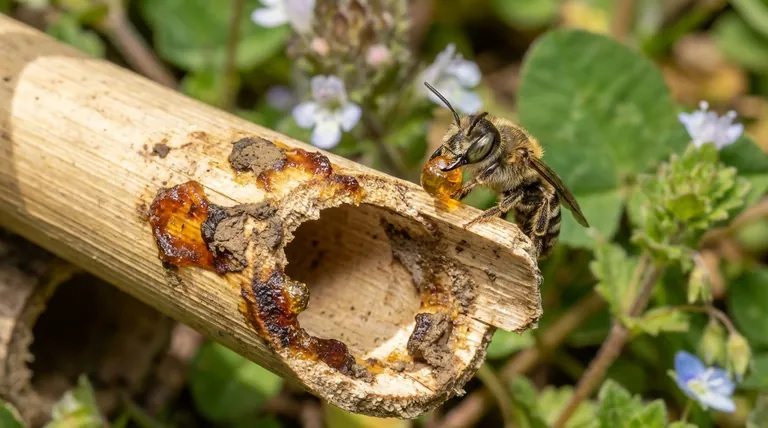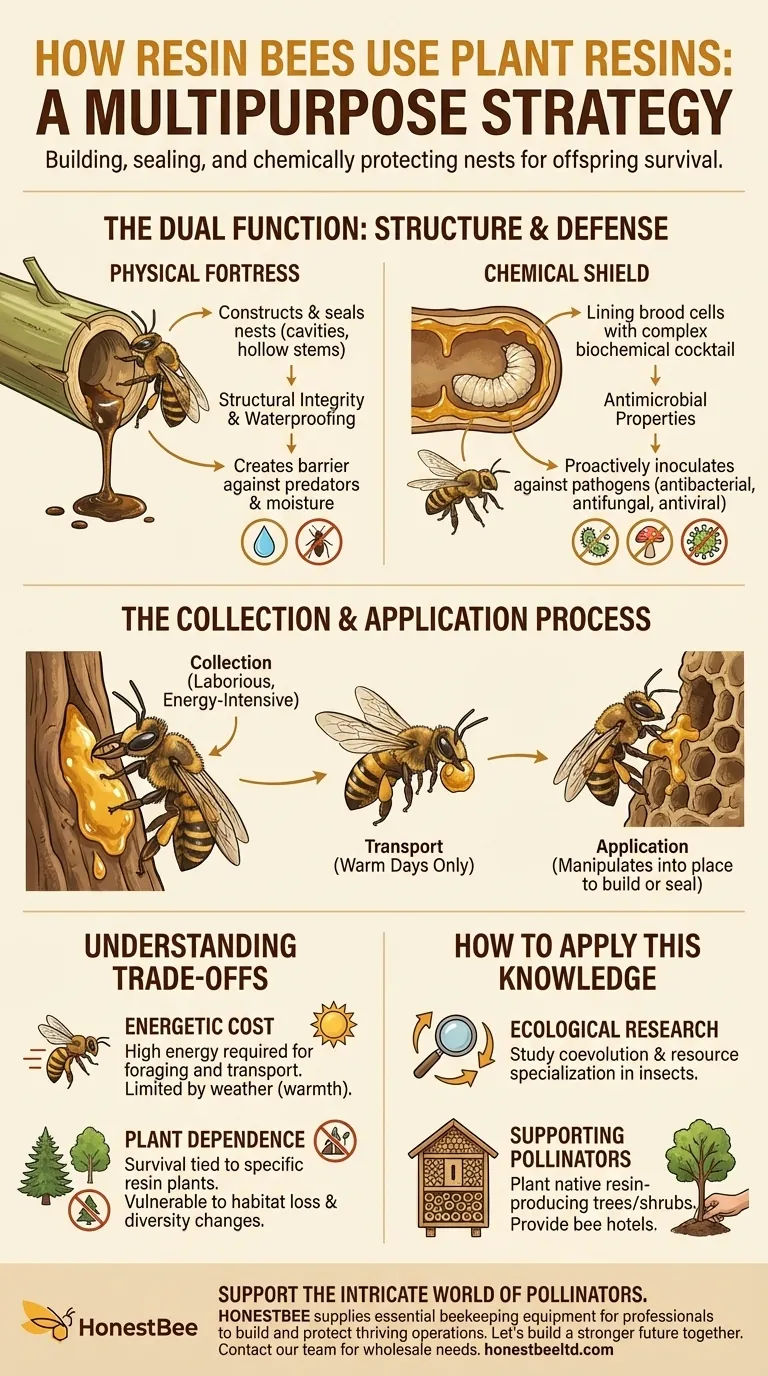In essence, resin bees use plant resins as a multipurpose construction material to build, seal, and chemically protect their nests. They meticulously gather these sticky substances and apply them to create a safe, fortified environment for their offspring, shielding them from predators, moisture, and disease.
The use of plant resin by these bees is not merely structural; it is a sophisticated survival strategy. The resin acts as both a physical barrier and a potent antimicrobial shield, effectively turning the nest into a self-disinfecting nursery.

The Dual Function of Resin: Structure and Defense
To understand why resin is so critical, we must look at its two primary functions. It serves as both the mortar for the nest's structure and the medicine for its inhabitants.
Creating a Physical Fortress
Resin bees use the substance to construct and seal their nests, which are often located in pre-existing cavities like hollow stems or beetle burrows.
The resin provides exceptional structural integrity and waterproofing. By lining the nest and sealing the entrance cap, the bee creates a formidable barrier that keeps the developing larvae dry and safe from environmental fluctuations.
This hardened seal also provides a crucial defense against predators and parasites that might otherwise invade the nest to prey upon the vulnerable brood.
A Chemical Shield for the Brood
Beyond its physical properties, plant resin is a complex cocktail of biochemical compounds. This is where its most critical function lies.
Resins possess powerful antimicrobial properties, including antibacterial, antifungal, and antiviral effects. When a resin bee lines its brood cells with this material, it is proactively inoculating the nursery against pathogens.
This chemical defense is vital for ensuring the health and survival of the eggs and larvae, which would otherwise be highly susceptible to fungal or bacterial infections in a damp, enclosed space.
The Collection and Application Process
The process of gathering resin is laborious. The female resin bee uses her powerful mandibles (jaws) to scrape or bite off chunks of resin directly from a plant source, such as a tree wound or leaf bud.
She then carries this sticky ball of resin back to the nest, still held in her mandibles, and carefully manipulates it into place to construct or seal the brood cells.
Understanding the Trade-offs
While highly effective, this reliance on resin comes with inherent costs and limitations that shape the bee's life and habitat.
The Energetic Cost of Collection
Finding and transporting resin is an energy-intensive task. The bee must locate a suitable source and make numerous trips to gather enough material for even a single nest.
Furthermore, resin is only malleable enough to be collected on warm days. This constrains the bee's foraging activity to specific times and weather conditions, limiting its productivity.
Dependence on Plant Resources
The survival of resin bees is directly tied to the availability of specific resin-producing plants within their flight range.
Habitat loss or changes in plant diversity can therefore have a direct negative impact on resin bee populations. They are specialists that depend on a healthy, diverse ecosystem to provide the materials they need to reproduce.
How to Apply This Knowledge
Understanding this behavior allows us to better support these fascinating and effective pollinators.
- If your primary focus is ecological research: The interaction between resin bees and plants is a prime example of coevolution and resource specialization in insects.
- If your primary focus is supporting pollinators: Planting native trees and shrubs known to produce resin (like pines and poplars) and providing nesting habitats (like bee hotels with hollow reeds) can directly support local resin bee populations.
Ultimately, the resin bee's strategy transforms a simple cavity into a highly advanced and protected environment for the next generation.
Summary Table:
| Function | Purpose | Benefit to the Bee |
|---|---|---|
| Structural Integrity | Building and sealing nest cells | Creates a physical fortress against predators and moisture |
| Chemical Defense | Lining brood cells | Provides antibacterial, antifungal, and antiviral protection |
| Resource Specialization | Dependence on specific plants | Highlights a sophisticated survival strategy and coevolution |
Support the intricate world of pollinators.
Just as resin bees rely on specific materials, commercial apiaries and distributors depend on high-quality, reliable equipment for success. HONESTBEE supplies the essential beekeeping supplies and equipment that professionals like you need to build and protect thriving operations through our wholesale-focused services.
Let's build a stronger future for beekeeping together. Contact our team today to discuss your wholesale needs.
Visual Guide

Related Products
- Professional Long-Handled Silicone Honey Scraper for Beekeeping
- Honey Wax Separating Wax Press with Metal Screw Wax Separator Machine
- Stainless Steel Honey Press Wax Press with Tank
- Premium Heat-Resistant Glass Honey Dipper
- Stainless Steel Pail Perch Bucket Bench
People Also Ask
- How much time does it take to do beekeeping? A Realistic Breakdown for Beginners & Pros
- What other tools are available for honey uncapping besides knives? Find the Right Tool for Your Apiary's Scale
- What type of bees are better adapted to certain climatic conditions? Match Bee Strategy to Your Climate for Success
- Why is it important to remove detached honeycomb pieces? Prevent Pests, Disease, and Robbing
- What are the basic components of beekeeping equipment? Build a Thriving Hive from the Start



















